Event – Home Entertainment 2001 Highlights
| Event – Home Entertainment 2001 Highlights |
| Frank Alles, Marshall Nack |
| 4 June 2001 |
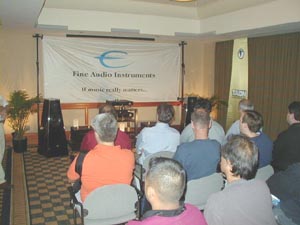 Stereophile’s Home Entertainment 2001 show, held May 11-13 at New York Hilton & Towers, provided me with the opportunity to see and hear some of the most outrageous and musical audio reproduction systems available today. I attended the event on Friday, May 11, and ran myself ragged in an attempt to cover as much ground as possible before the 8 PM closing. Nonetheless, it was a labor of love, and I thoroughly enjoyed myself, despite the generally crowded conditions and often-gridlocked elevator service – more on that below.
Stereophile’s Home Entertainment 2001 show, held May 11-13 at New York Hilton & Towers, provided me with the opportunity to see and hear some of the most outrageous and musical audio reproduction systems available today. I attended the event on Friday, May 11, and ran myself ragged in an attempt to cover as much ground as possible before the 8 PM closing. Nonetheless, it was a labor of love, and I thoroughly enjoyed myself, despite the generally crowded conditions and often-gridlocked elevator service – more on that below.
Top Honors
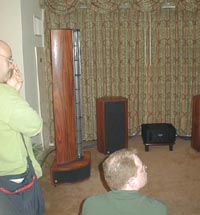 The Airfoil V bending-wave, line-source speakers fromImpact Technology at $35,000/pr. were simply smashing. Two independent and dedicated subwoofer cabinets, each containing two 12″ woofers, supply the deepest bass. Playing an eclectic drum recording, the Airfoil Vs had snap and thump to spare, while less bombastic selections seemed incisive, natural and well balanced. A less expensive model, the new Airfoil IV, incorporates six bending-wave drivers per side (compared with nine in the V) and sells for between $22k and $26k, depending on whether you order it with one or two subwoofers. The company plans to introduce yet less costly models over the next couple of years that will feature the new bending-wave technology. Kudos to Impact Tech!
The Airfoil V bending-wave, line-source speakers fromImpact Technology at $35,000/pr. were simply smashing. Two independent and dedicated subwoofer cabinets, each containing two 12″ woofers, supply the deepest bass. Playing an eclectic drum recording, the Airfoil Vs had snap and thump to spare, while less bombastic selections seemed incisive, natural and well balanced. A less expensive model, the new Airfoil IV, incorporates six bending-wave drivers per side (compared with nine in the V) and sells for between $22k and $26k, depending on whether you order it with one or two subwoofers. The company plans to introduce yet less costly models over the next couple of years that will feature the new bending-wave technology. Kudos to Impact Tech!
In my view, the visually intriguing MBA 101D omnidirectional speakers provided the best sounding high-frequency reproduction at the show. They presented truly holographic instrumental images that were harmonically rich and involving. Man, would I love to own the massive MBL solid-state, monoblock amps! They are as gorgeous as they are HUGE, with sound quality to match.
Stand-Outs
Audio Aero of France was conspicuous by its presence in a few of the exhibit rooms. Their Prima Series CD player features a 24/192 DAC with subminiature tube output for $1,695 USD. In gloss black with gold-plated knobs and accents, it’s a real eye-catcher. The company also makes a separate DAC for $3,840, and a gorgeous 50 wpc, class-A stereo tube amplifier priced at $8,400. The gear sounds as good as it looks.
Joseph Audio RM33si speakers: At $7,500/pr, the RM33si 3-way towers had a lightning fast, superbly focused and detailed presentation. The upper midrange tended toward brightness with some recordings, but under show conditions it’s difficult to isolate the cause for such things. The attractive, bolt-on, wood-veneer side panels can be easily swapped for other finishes when desired. They’re definitely worth an audition.
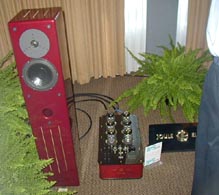 Merlin’s Millennium speakers with battery-powered BAM (bass augmentation module), and juiced by the regal looking Joule Electra VZN-100(100W) OTL monoblock amplifiers, sounded tight, transparent and well-balanced. The Millennium’s premium cabinet finish is most appealing.
Merlin’s Millennium speakers with battery-powered BAM (bass augmentation module), and juiced by the regal looking Joule Electra VZN-100(100W) OTL monoblock amplifiers, sounded tight, transparent and well-balanced. The Millennium’s premium cabinet finish is most appealing.
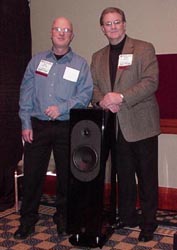 Roman Audio Systemsdebuted the Centurion, a handsome, 2-way, floor-standing speaker system shockingly adroit at reproducing violin, and acoustic guitar and bass. Priced at $5,495/pr., the piano black speakers were driven by Krell amplification. According to the company’s VP of Marketing, Nick Wingate, the speakers use a new patent-pending, capacitorless crossover technology from Ray Kimber and Bruce Bastian’s DiAural LLC.
Roman Audio Systemsdebuted the Centurion, a handsome, 2-way, floor-standing speaker system shockingly adroit at reproducing violin, and acoustic guitar and bass. Priced at $5,495/pr., the piano black speakers were driven by Krell amplification. According to the company’s VP of Marketing, Nick Wingate, the speakers use a new patent-pending, capacitorless crossover technology from Ray Kimber and Bruce Bastian’s DiAural LLC.
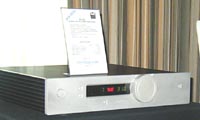 I have to admit I was VERY impressed with the demonstration of the TACT digital electronics featuring digital room correction. I believe the Danish firm was using its flagship digital amplifier, the $9,800Millennium Mk.2, and is introducing two new lower-priced digital amps, the S2150 and M2150, available this June. TACT’s digital processing enabled the unassuming Dali Grand speakers from Denmark ($5,000/pr, but unavailable in the US) to sound extremely unencumbered, fast and dynamic, with surprisingly forceful and agile bass – sound quality that rivaled the top systems at the show!
I have to admit I was VERY impressed with the demonstration of the TACT digital electronics featuring digital room correction. I believe the Danish firm was using its flagship digital amplifier, the $9,800Millennium Mk.2, and is introducing two new lower-priced digital amps, the S2150 and M2150, available this June. TACT’s digital processing enabled the unassuming Dali Grand speakers from Denmark ($5,000/pr, but unavailable in the US) to sound extremely unencumbered, fast and dynamic, with surprisingly forceful and agile bass – sound quality that rivaled the top systems at the show!
Tenor Audio of Quebec, Canada showed two extremely competent sounding and sexy looking OTL power amplifiers with seductive, oiled cherry wood chassis panels. A 75-Watt monoblock using four 6C33C-B output tubes and a 15-Watt monoblock using two of the same output tubes on each chassis are available. Balanced and RCA inputs are provided. Additionally, integrated versions of each amp with volume controls and three switched inputs (gold-plated knobs) are offered. Through the highly efficient RL Acoustique speakers (using Lowther drivers), the presentation was involving and detailed. The solid-state power regulation is claimed to provide robust, well-controlled bass.
Did everyone catch the Wilson WATT/PUPPY 6/Spectral/MIT demonstration atInnovative Audio’s room? The system had bass to die for. My pants were literally flapping. A sprightly selection featuring Stanley Clarke on electric bass couldn’t have sounded any more real. Most Impressive! The demo, however, was much too brief for me to accurately gauge the overall musical performance of the system. I hope to hear it under more favorable conditions in the future. Maybe they’ll lend it to me.
Bang for the Buck
My vote for most bang for the buck goes to the Newform Research R645 ribbon hybrid speakers ($2,265/pr.) – for the money, simply a steal. The hybrid system, with its closed-back, 45″ ribbon tweeter array, produced some of the most musical and least congested sound I have heard.
Those into home theater will appreciate the offerings from Outlaw Audio. This Web-based enterprise demonstrated its Outlaw 1050 6.1-channel digital receiver (65 Wpc/6 channels driven) that honestly sounded GOOD playing a discrete DVD-A multi-channel recording through a surround speaker system composed of Diva speakers. The company also has plans to market a six-channel bass management device with adjustable crossover points for each channel called the Integrated Controlled Bass Manager (ICBM), that will sell for $249. Products from Outlaw Audio and Diva speakers are available from AV123.com.
What Color?
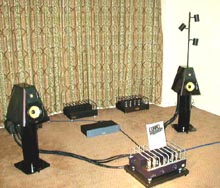 Legend Audio managed to achieve very respectable sound quality from its 50 wpc Starletintegrated amp driving its $4,000/pr., two-way monitors. The sound of a steel-drum recording was musical and enjoyable. The stylish, truncated-pyramidal speakers are available in very attractive finishes including one (my favorite) that looked like metallic root beer (Chameleon, $500 extra). Sweet! Visually, the Legend amplifiers are a little too basic for my taste, and their color options are a bit, well, unusual.
Legend Audio managed to achieve very respectable sound quality from its 50 wpc Starletintegrated amp driving its $4,000/pr., two-way monitors. The sound of a steel-drum recording was musical and enjoyable. The stylish, truncated-pyramidal speakers are available in very attractive finishes including one (my favorite) that looked like metallic root beer (Chameleon, $500 extra). Sweet! Visually, the Legend amplifiers are a little too basic for my taste, and their color options are a bit, well, unusual.
Missing the Mark
Rogue Audio showed its no-nonsense line of tube electronics, including its newTempest integrated amp ($2,195 with remote). The Pennsylvania-based company achieved a reasonably detailed presentation with competent imaging using the Audio Physic Spark III speakers. But, the sound was a bit too thin to be taken seriously.Totem Acoustics had the opposite problem. Their new Wind speakers were blowing bass out of all proportion to the midrange and highs.
Coming Soon
El Jefe Grande, Mark Schifter of Perpetual Technologies, announced the launch of the upcoming speaker line, Genesis 2000, that will be direct-marketed viaAV123.com sometime this fall. The new speakers will use Vifa and proprietary Genesis drivers, custom crossovers by famed designer Arnie Nudell, and unique, hand-rubbed, high-gloss, multi-tone cabinets. A rather ambitious five-driver model, the Genesis C, will cost about $3,500. Smaller, less expensive models will be offered as well. The cabinets were on display – sans drivers!
Scull’s Folly: One Butt Too Many
Many at this year’s show complained about the NY Hilton’s slow and confusing elevator service. One man sent this first-hand account. Be thankful that you were not in his shoes.
Date: Sun, 13 May 2001 07:40:56 -0400
From: Gerald “Andy” Andeskie
Subject: Why I missed the 5 pm Phonogram* meeting at the Stereophile ShowIt was Friday, a little after 4 pm, and I had not yet been to the 42nd floor. After waiting in the lobby for what seemed to be an eternity, I was finally able to get on to an elevator that would go the distance (it seems only a few would go this high, hence the delay). I got on, along with another 14 audiophiles—we packed the elevator. Just as the doors were starting to close, none other than Stereophile’s Jonathan Scull and his wife Katherine (K10) appeared. To the horror of all on board, Jonathan turned around, took hold of his wife’s hand, and backed into the elevator (all that was missing was a beeping sound), effectively pushing us all back tighter still. I was the lucky one to have his backside pushed directly into my front in such a manner that if he were—let’s say Mark Levinson’s Kim Katrell—I would have been a very happy guy. We now numbered 17 in an elevator designed for 10.
The elevator began to rise as commanded, perhaps a few floors, before it came to a sickening stop. Jonathan and I were able to reach a few of the buttons, but none would stay lit. We were able to hit the alarm—keep in mind when I say, “we were able,” I mean just that—with careful positioning of our limbs, we could negotiate the reach. It was that tight. The bell rang, but there was no evidence of any help coming. We were now starting to panic. One could sense everyone trying to calm themselves silently, stay cool and not over-react—breathe calmly, slowly, in and out. It was hot and smelly, as no air circulated. The guy behind me was able to get to his cell phone for a 911 call, but he had no signal strength. There was a guy at the center door seam who was strong enough to pry open the doors with his hands. This allowed for some cooler air to enter the elevator, but also revealed to us that we were slowly descending. As we passed a floor, he tried to pry open the outer doors to set us free. Due to a double latch mechanism, he failed twice. The third time I was able to reach over and release the second latch while he hit the first, which finally set us free.
We piled out into the lobby, breathing cool air and a sigh of relief. Jonathan, in a decidedly contrite fashion, offered his sincere apologies to all of us as we left.
After taking some time to recompose myself I got back on another elevator (the original was no longer in service) and finally got up to the 42nd floor. I had no intention of descending until I saw all that I wanted.
And that is why I missed the Phonogram* meeting at 5 pm.
Apologies to all.
Andy Andeskie
*Phonogram is a private e-mail list for analogue recording aficionados.
The above correspondence was published with permission from Mr. Andeski.
Marshall Nack
This year’s Home Entertainment show was smaller than either the winter CES or the last Stereophile show in NYC. (Was that really five years ago?) Exhibitors occupied five floors, and registration and promotional materials were well organized. The crowds were large, so it was often difficult to get on an elevator. However, the good turnout does necessarily imply success from a business viewpoint. For the audiophile, however, there were lots of good-sounding rooms. Strange to say, it seemed the rooms with the big speakers had the most problems.
The second floor featured accessories and music software for sale. Discounts were slim on CDs and LPs. Hardware gizmos – cables, footers, etc. – were available at better discounts. On an upbeat note, there was an ample amount of analog on display, with half dozen or so rooms spinning vinyl. SET amps, all the rage a few years ago, were hardly in evidence.
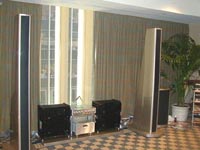
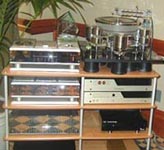
HP had his own room filled with TAS’s top-shelf choices: Burmester digital, Clearaudio analog, conrad-johnson pre-amp, Wisdom loudspeaker system, Edge power amp on bottom, VTL amp on top, Groove Phono Stage, and Nordost wiring. The system came in at a whopping $236,045! They actually posted the numbers! The sound was amazingly clear, transparent and immediate; dynamics, startling and seemingly effortless. Pure, unrestrained power, thunderclap capable. Glare, grain or other artifacts absent on analog or digital. Were the room measured, I bet it would be linear at least to 20 hz. It was overwhelming and larger than life. At the same time, I could not relax.
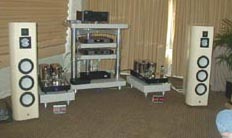 VAIC components and Lumen White speakers. I had not seen any of this gear before. I think we’re going to hear more about it soon. The system consisted of the VAIC 52B monoblocks, imported from Italy, at $19,750; the DCS Polarus and Delirus upsampler and DAC; and Lumen White “White Light” speakers, imported from Austria, MSRP $38,000.Synergistic Research Active Shielding cables tied it all together. Everything sat on modular Acoustic Dreams racks and component supports. I loved the sound of a classical ensemble performing modern chamber works on an unidentified Italian CD: refined and delicate, yet solid. When the program changed to Patricia Barber, the fragile child transformed into a power machine. This setup could do it all.
VAIC components and Lumen White speakers. I had not seen any of this gear before. I think we’re going to hear more about it soon. The system consisted of the VAIC 52B monoblocks, imported from Italy, at $19,750; the DCS Polarus and Delirus upsampler and DAC; and Lumen White “White Light” speakers, imported from Austria, MSRP $38,000.Synergistic Research Active Shielding cables tied it all together. Everything sat on modular Acoustic Dreams racks and component supports. I loved the sound of a classical ensemble performing modern chamber works on an unidentified Italian CD: refined and delicate, yet solid. When the program changed to Patricia Barber, the fragile child transformed into a power machine. This setup could do it all.
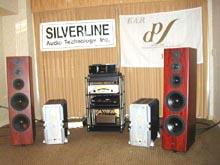 EAR electronics and Silverline Audio speakers worked wonderfully together. The room featured the EAR M100A mono block amps: single-ended, transformer-coupled, solid-state designs putting out 100 watts, the latest from Tim de Paravichini (MSRP $35,000). From the same line, the EAR 312 Control Centre pre-amp ($18,000), which sports a built-in phono stage. Speakers, the handsomeSilverline Sonata ($6,000). After dropping in on so many rooms of speakers in the five-figure area, I had to ask twice about the price of the Sonatas. Their looks and performance were the equal of many of those big boys.
EAR electronics and Silverline Audio speakers worked wonderfully together. The room featured the EAR M100A mono block amps: single-ended, transformer-coupled, solid-state designs putting out 100 watts, the latest from Tim de Paravichini (MSRP $35,000). From the same line, the EAR 312 Control Centre pre-amp ($18,000), which sports a built-in phono stage. Speakers, the handsomeSilverline Sonata ($6,000). After dropping in on so many rooms of speakers in the five-figure area, I had to ask twice about the price of the Sonatas. Their looks and performance were the equal of many of those big boys.
Florence Audio Technology. This speaker manufacturer was getting some very impressive sound from their Pololena model ($3,500 to $4000), connected via home-made wires to ten-year-old electronics – PS Audio Digital Link II and theSONY S3000 as a transport. I returned several times. The manufacturer claims these diminutive speakers go down to 20 Hz, depending on room characteristics. Seeing may not be believing, but hearing sure is. They went down deep.
 The Legend Audio Design room gets the Golden Glow award. I also returned here several times to hear the beguiling sounds via the best in tubes and their smallish Legend speakers ($3,995), with their impressive frequency extension and good dynamics. Friday featured their Starlet integrated amp ($3,000), Saturday, their new Nirvana monoblocks ($6,500) and Moonlite line pre-amp($2,250). A modified Phillips 960 CD Transport fronted the Legend Music Reference DAC($4,995). The sound was always musical, refined, and without strain. Like sitting in one of those Swedish stress-reduction chairs. You don’t want to leave. The Legend speakers filled the room with unforced, realistically dynamic sound, without a trace of strain or hardness.
The Legend Audio Design room gets the Golden Glow award. I also returned here several times to hear the beguiling sounds via the best in tubes and their smallish Legend speakers ($3,995), with their impressive frequency extension and good dynamics. Friday featured their Starlet integrated amp ($3,000), Saturday, their new Nirvana monoblocks ($6,500) and Moonlite line pre-amp($2,250). A modified Phillips 960 CD Transport fronted the Legend Music Reference DAC($4,995). The sound was always musical, refined, and without strain. Like sitting in one of those Swedish stress-reduction chairs. You don’t want to leave. The Legend speakers filled the room with unforced, realistically dynamic sound, without a trace of strain or hardness.
The LINN suite. I enjoyed the Linn signature sound, especially from their fully-decked out LP12 turntable ($10,000). The all-Linn system featured their new speakers, the Komri Professional ($40,000), Klimax amps ($9,500 each), the CD12 player, the Linn 5103 System Controller ($7,000). The Komri’s four drivers were each driven by a separate Klimax amp, for a total of eight Klimaxes, yielding a staggering 1000 watts per channel. Folks, this could be your desert island system. It sure won’t fit into your apartment, though. Unfortunately, this room was adjacent to a home theatre demo with its 30-second-interval earthquakes.
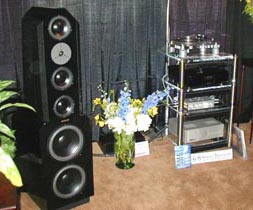 EgglestonWorks speakers and Nagra electronics. The main room showed off the new EgglestonWorks SAVOY speakers ($40,000), along with the new Nagra MPA 250-watt solid state stereo amp ($12,000). Supporting these newcomers were a Nagra PLL tube line pre-amp ($6,800), a Basisturntable with Graham arm and Benz Micro II cartridge, and SONY 777ES CD player. The SONY was being used everywhere. Hearing the Nagra D2 digital tape machine ($28,000) provided a real treat. The second room featured the EgglestonWorks Fontaine($4,900), their new subwoofer (as yet unnamed at $2,700), the Nagra VPA amp ($12,000), and Theta Casablanca and Carmen transport. Both rooms were wired up with Harmonic Tech cabling.
EgglestonWorks speakers and Nagra electronics. The main room showed off the new EgglestonWorks SAVOY speakers ($40,000), along with the new Nagra MPA 250-watt solid state stereo amp ($12,000). Supporting these newcomers were a Nagra PLL tube line pre-amp ($6,800), a Basisturntable with Graham arm and Benz Micro II cartridge, and SONY 777ES CD player. The SONY was being used everywhere. Hearing the Nagra D2 digital tape machine ($28,000) provided a real treat. The second room featured the EgglestonWorks Fontaine($4,900), their new subwoofer (as yet unnamed at $2,700), the Nagra VPA amp ($12,000), and Theta Casablanca and Carmen transport. Both rooms were wired up with Harmonic Tech cabling.
![]()
Don’t forget to bookmark us! (CTRL-D)
Stereo Times Masthead
Publisher/Founder
Clement Perry
Editor
Dave Thomas
Senior Editors
Frank Alles, Mike Girardi, Key Kim, Russell Lichter, Terry London, Moreno Mitchell, Paul Szabady, Bill Wells, Mike Wright, Stephen Yan, and Rob Dockery
Current Contributors
David Abramson, Tim Barrall, Dave Allison, Ron Cook, Lewis Dardick, Dan Secula, Don Shaulis, Greg Simmons, Eric Teh, Greg Voth, Richard Willie, Ed Van Winkle, and Rob Dockery
Music Reviewers:
Carlos Sanchez, John Jonczyk, John Sprung and Russell Lichter
Site Management Clement Perry
Ad Designer: Martin Perry





Be the first to comment on: Event – Home Entertainment 2001 Highlights